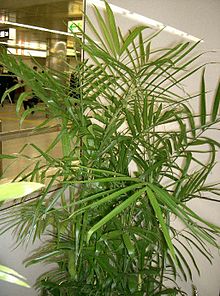Chamaedorea seifrizii
| Chamaedorea seifrizii | |
|---|---|

| |
| Scientific classification | |
| Kingdom: | Plantae |
| Clade: | Tracheophytes |
| Clade: | Angiosperms |
| Clade: | Monocots |
| Clade: | Commelinids |
| Order: | Arecales |
| Family: | Arecaceae |
| Genus: | Chamaedorea |
| Species: | C. seifrizii |
| Binomial name | |
| Chamaedorea seifrizii | |
| Synonyms[2] | |
Chamaedorea seifrizii, commonly known as bamboo palm, parlor palm, or reed palm, is a species of plant in the family Arecaceae. It is a subtropical palm that grows up to 20 feet tall, and is commonly used as a houseplant.[3] The evergreen leaves are pinnately divided, and yellow flowers are borne on a panicle.[4] The fruit are small, round, and black.[5]
Taxonomy and history
Chamaedorea seifrizii was described in 1938 by German botanist Max Burret based on a type specimen collected near Chichén Itzá in Mexico. Burret named the species in honour of William Seifriz, the collector of the type material. The holotype has since been lost, but a neotype was designated by Donald R. Hodel in 1992 and is now stored in the Liberty Hyde Bailey Hortorium.[6][7]
Distribution and habitat
C. seifrizii is native to Belize (Belize District, Cayo District, Corozal District, and Orange Walk District), Guatemala (Petén Department), Honduras (mainland and Islas de la Bahia), and Mexico (Campeche, Quintana Roo, Tabasco, and Yucatán). It can be found at elevations of up to 500 m (1,600 ft), often on limestone outcrops. It grows in moist woodlands and forests, including disturbed habitat.[1][6]
It occurs as an introduced species in Florida, United States.[5]
Cultivation
Referred to as xate, xiat, or chiat in Mayan, C. seifrizii was cultivated by the Maya people in the pre-Columbian era as an ornamental plant and possibly for religious purposes, often being planted around villages and temples.[6]
Today, C. seifrizii is widely cultivated as both an indoor and outdoor plant.[6] It is easily propagated from seed or by division.[8]
References
- ^ a b Samain, M.-S.; Machuca Machuca, K.; Martínez Salas, E. (2022). "Chamaedorea seifrizii". IUCN Red List of Threatened Species. 2022: e.T58410095A58410234. doi:10.2305/IUCN.UK.2022-1.RLTS.T58410095A58410234.en. Retrieved 12 November 2022.
- ^ "Chamaedorea seifrizii Burret". Plants of the World Online. Royal Botanic Gardens, Kew. Retrieved 18 July 2024.
- ^ "Chamaedorea seifrizii (Bamboo Palm, Parlor Palm, Reed Palm)". North Carolina Extension Gardener Plant Toolbox. North Carolina State University and North Carolina A&T State University. Retrieved 17 April 2022.
- ^ "Chamaedorea seifrizii". Royal Horticultural Society. Retrieved 17 April 2022.
- ^ a b Zona, Scott. "Chamaedorea seifrizii". Flora of North America. Retrieved 31 July 2024.
- ^ a b c d "Chamaedorea seifrizii Burret, Notizbl. Bot. Gart. Berlin-Dahlem 14: 268 (1938)". Palmweb. Retrieved 31 July 2024.
- ^ Reveal, James L.; Nixon, Kevin C. (2013). "The palm type collection in the Liberty Hyde Bailey Hortorium (BH)". Phytoneuron. 2013–79: 15. ISSN 2153-733X – via Biodiversity Heritage Library.
- ^ Jones, David L. (1995). Palms Throughout the World. Smithsonian Institution Press. p. 178. ISBN 1560986166. LCCN 95068615. OCLC 33124561.

